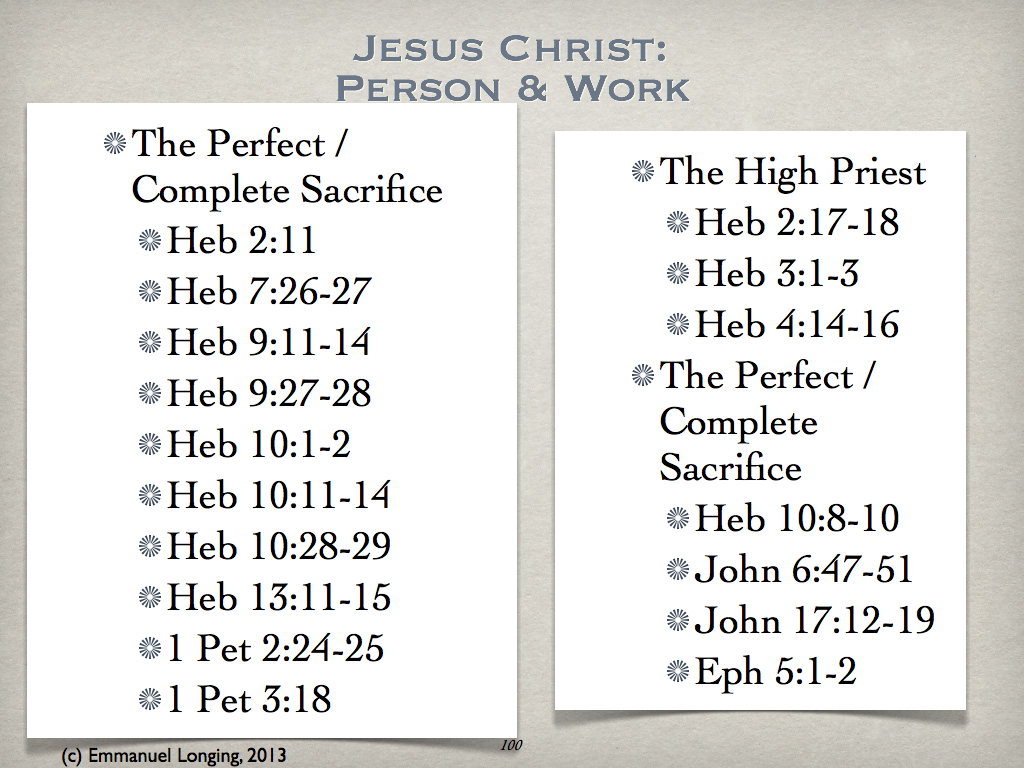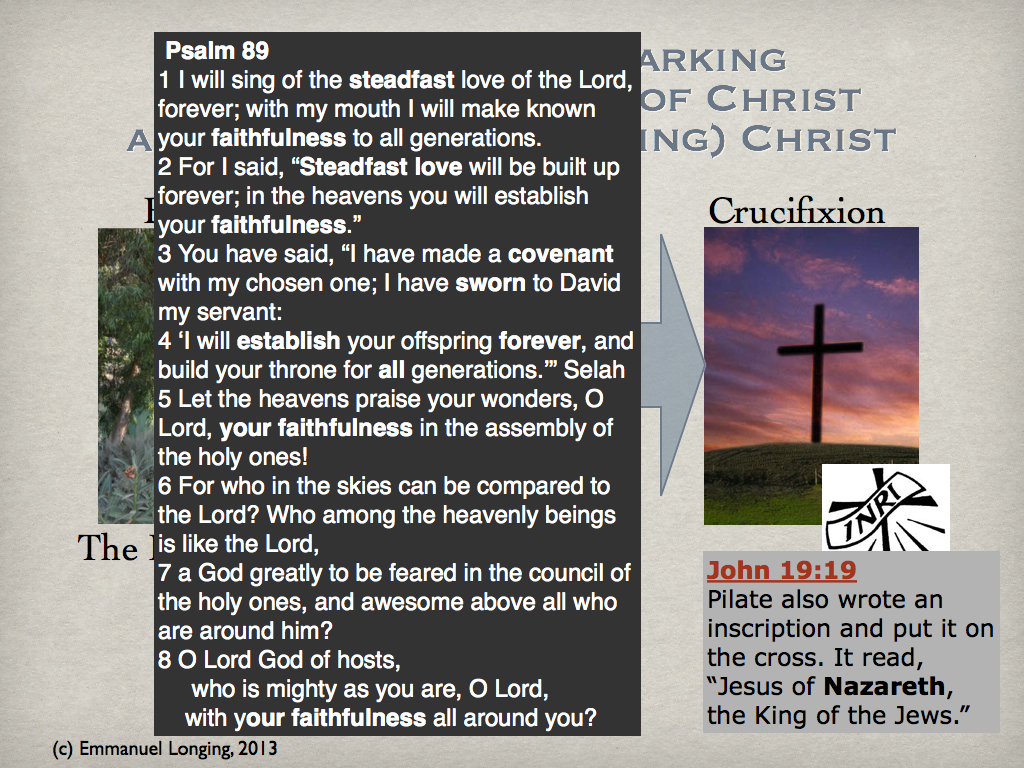We have discussed previously the ‘bookend’ events of Christ’s public ministry, the Baptism by John where Jesus is identified as the Lamb of God who takes away the sins of the world (that’s you and me, too), and the Crucifixion of the Cross which had the joined hands of the official Jewish leadership (the Pharisees and Sadducees) with the Roman Government (Pontus Pilate).
We also considered “baptism” as representing something far deeper than water and washing, namely: identification. The people coming to John for baptism were identifying publicly their repentance from any idea that Law keeping was or could accomplish their self-redemption from sin. Jesus came to John for a very different identification purpose. John himself when he saw Jesus, he initially refused to baptize Him because he recognized that Jesus had no need for identification with such repentance. But Jesus told him to proceed and in the process John received the sign from God that this Jesus was to be the Father’s very Passover Lamb.
So that second event, the one completing the bookend, the Cross, is another identification moment, just as the Baptism one was. The identification that takes place on the Cross is the very fulfillment of the identification that occurred at His Baptism. The central event of the ages takes place on Golgotha’s Hill, on a Roman Cross, under the accusation by the Jews that He had made Himself out to be God, and by which God placed on Jesus all the sins requiring redemption (including yours and mine). The horror of the scourging which marred Him (the Scripture says) more than any man, and the horrific agonies of the Cross were used by God to give evidence to a deeper but invisible horror whereby all the judgment of our sins and sin nature were placed in Christ and covered forever by His sacrifice. This is just astonishing, but it is what Scripture teaches. Chris’s Resurrection, later Ascension, and descent of the Holy Spirit to indwell us, and direct the writing of the New Testament Scriptures, becomes the evidence that Christ’s sacrificial work was sufficent. The transaction is complete. God has no more to charge against us. Nothing separates us from the love of the Father.
This incredible identification and result was foretold in many places in the Old Testament. Including great passages such as the institution of the Passover itself that begins and launches the Book and event of Exodus, to Isaiah 53 of the suffering servant, the Lamb of God, to many of the Psalms, including Ps 89 shown below glorifying the faithfulness of the Lord (YHWH, i.e., Jesus Christ).
One of the great ironies of the events at that time was the writing of Pilate, the Roman Governor, identifying the charge under which Jesus was crucified. We know from Scripture that Pilate wrote in Greek, Hebrew, and Aramaic, “Jesus of Nazareth King of the Jews.” (Roman Catholics put the Latinized first letter of this phrase on their cross reproductions: I (“Jesus” begins with an “I”), N (Nazareth), R (“Rex,” Latin for King), I (“Jews” begins with an “I”), or INRI). Here’s the irony: in Hebrew, the abbreviated phrase, which is likely what Pilate actually wrote, is YHWH–the Tetragrammaton!–by the the first letters of “Yeshua Ha’Nazarei W‘Melech Ha’Yehudim” saying Yeshua (Jesus) HaNaraei (from or of Nazareth) W’Melech (King) of the Jews (Ha’Yehudim). This was deeply insulting to the Jews on many levels. Writing out YHWH was a sacred act, which certainly should not have been done by a Roman, nor put on the cursed cross (the Old Testament Scriptures clearly say that “cursed is every man who hangs on a tree”), and most of all they had delivered up Jesus to be crucified because they had understood that this was exactly what Jesus had claimed Himself to be, which they had rejected and then necessarily demanded the curse of crucifixion for the utmost blasphemy (in their eyes). And, here, the Roman crucifier writes directly above Jesus’s head, for all to see and ponder, the very claim that Jesus had made! They immediately prevailed upon Pilate demanding that he say instead that Jesus had claimed (said) that he was the king of the Jews, not that he was the king of the Jews. Pilate only responded with “what I have written I have written,” so that has stood as the Gentile declaration for now 2,000 years, and it is true: Jesus was from Nazareth, but He was also the King of Jews, and most importantly He was the very Lord of the Bible, doing the very essence of His work on that Cross.
Why did the Jewish leaders want Jesus crucified. Could not a simple execution such as by stoning have accomplished their purpose, namely to remove the threat to their place and authority? No. Their problem, and the skeptic’s problem to this day, is that Jesus’s words and works carried an overpowering good toward all its witnesses, including us to this day. Simply stoning Jesus would have been an obvious attempt by the Jewish leaders to remove anyone who threatened their rank and position. But all the Jews knew the Old Testament’s characterization of death by hanging on a tree, such as by a literal hanging as was the outcome of the infamous hater of the Jews, Haman (Book of Esther), or Absalom (the rebellion leader against God’s anointed King, David). So the Jewish leaders believe, by setting up the circumstances whereby the Roman’s crucified Jesus they would obscure their role and most importantly conclusively and finally (in their mind) demonstrate that what the people had thought was “good” about Jesus was actually deeply evil because God had seen fit to judge Jesus by both a horrific death but also the death sign of a curse all by the hands of the Romans. This exceedingly cunning plan was intended not just only to get rid of Jesus but to exterminate any favorable memory of Him.
How mistaken they were, on so many levels.
The Person and Work of the Lord Jesus Christ is the basic focus of the entire New Testament. Below are just a few of the key ideas expressed. 
Such Work of Christ, did many things–more than we can understand this side of eternity. One dimension is that we are now both anointed and a dwelling place of God’s very Spirit.
